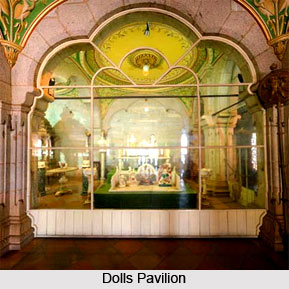 Dolls Pavilion in Mysore Palace was originally meant to display dolls during the Dasara festival. Mysore Palace which is also known as the Amba Vilas Palace is a palace situated in the city of Mysore in southern India. Mysore Palace is the official residence of the Wodeyars - the former royal family of Mysore that ruled the princely state of Mysore for over seven centuries. Dolls Pavilion is one of them.
Dolls Pavilion in Mysore Palace was originally meant to display dolls during the Dasara festival. Mysore Palace which is also known as the Amba Vilas Palace is a palace situated in the city of Mysore in southern India. Mysore Palace is the official residence of the Wodeyars - the former royal family of Mysore that ruled the princely state of Mysore for over seven centuries. Dolls Pavilion is one of them.
Wodeyar kings first built a palace in Mysore in the 14th century. Later the Mysore Palace was demolished and constructed multiple times. The current palace construction was commissioned in 1897 that is the time of British rule, and it was completed in 1912 and expanded later around 1940.
It is a tradition in Mysore to worship dolls during Dasara festival, a tradition which was inherited from the Vijaynagar times. In many parts of India, Dasara is known as Navaratri. In Karnataka, Dasara is celebrated in the month of October with great festivity. People from all over the state take part in this amazing festival. Mysore is the city of silk and sandalwood and till date it remains the centre for traditions, culture and art. The city is often referred to as the `City Royale` and Dasara is considered to be a Royal festival celebrating the victory of good over evil.
In Karnataka, Dasara is celebrated as Nadahabba. The celebration has its roots in the royal family of Mysore. They perform a special puja during this festival. During these festivities, in every house, dolls were tastefully arranged. This tradition continues even today. During the time of Wodeyar kings, this area was opened to public. Today, the bays of the western part of Gombe Thotti or the Dolls Pavilion house a collection of various objects of art including European marble sculptures acquired by the royalty. All the dolls displayed here are from the Maharaja`s personal collection. Most of the items were acquired in the 1920`s.
At the left there is neo-classical marble structure from Europe. At the centre is sitting a lavish wooden pavilion decorated in mirror work of Rajasthan with Lord Ganesha the elephant- headed god. Ganesha Veena is portrayed playing a "veena". This instrument is widely used in Carnatic Music.The southern and the northern parts of the Gombe Thotti, are separated by a passage leading to Mysore Palace courtyard. It has a brass gate consisting of two parts. It is known as Ane Bagilu or Elephant Gate.




